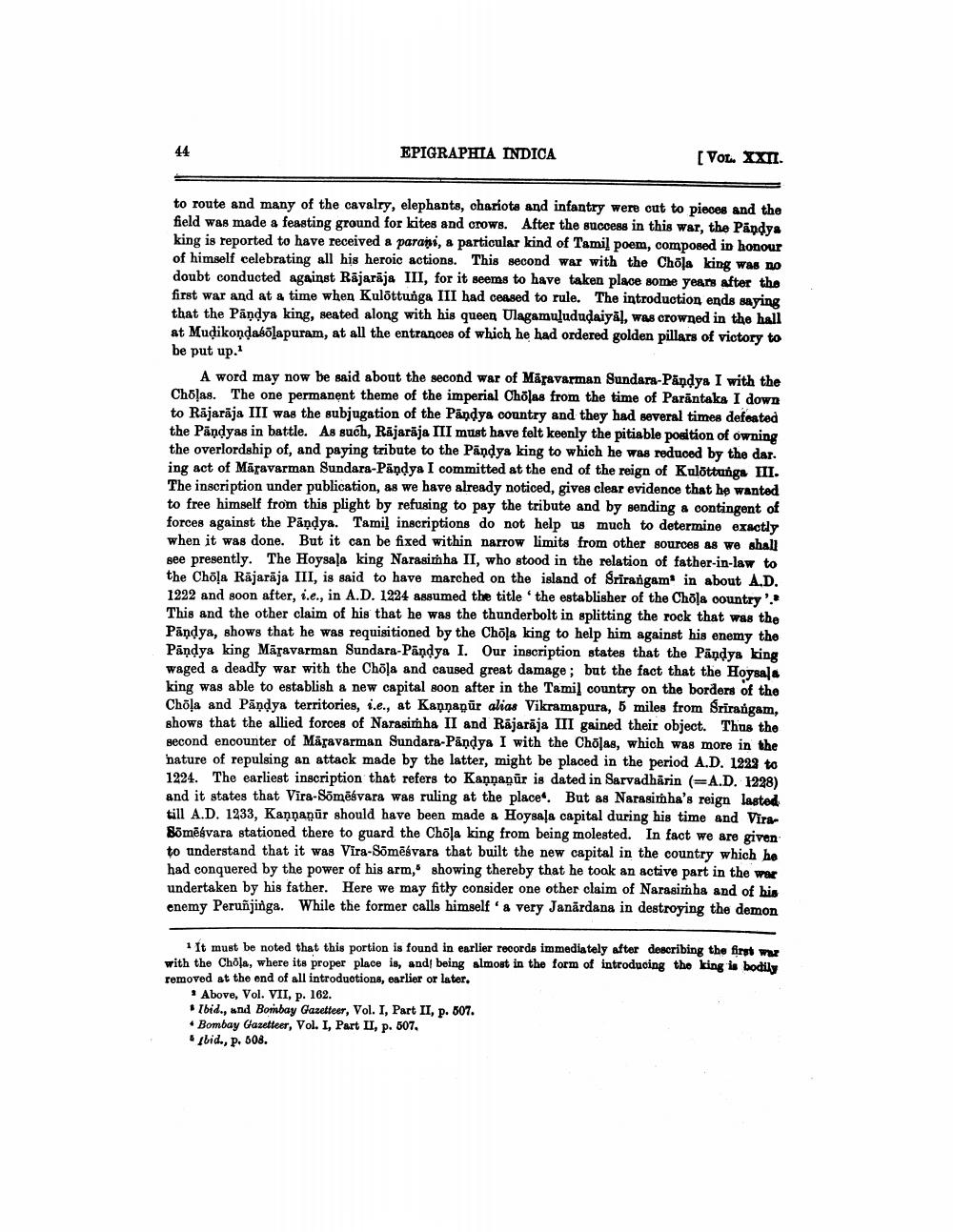________________
44
EPIGRAPHIA INDICA
[VOL. XXII.
to route and many of the cavalry, elephants, chariots and infantry were cut to pieces and the field was made a feasting ground for kites and crows. After the success in this war, the Pandya king is reported to have received a parani, a particular kind of Tamil poem, composed in honour of himself celebrating all his heroic actions. This second war with the Chōla king was no doubt conducted against Rajaraja III, for it seems to have taken place some years after the first war and at a time when Kulottunga III had ceased to rule. The introduction ends saying that the Pandya king, seated along with his queen Ulagamulududaiyal, was crowned in the hall at Mudikonḍaśõlapuram, at all the entrances of which he had ordered golden pillars of victory to be put up.1
A word may now be said about the second war of Maravarman Sundara-Pandya I with the Chōlas. The one permanent theme of the imperial Cholas from the time of Parantaka I down to Rajaraja III was the subjugation of the Pandya country and they had several times defeated the Pandyas in battle. As such, Rajaraja III must have felt keenly the pitiable position of owning the overlordship of, and paying tribute to the Pandya king to which he was reduced by the dar. ing act of Maravarman Sundara-Pandya I committed at the end of the reign of Kulottunga III. The inscription under publication, as we have already noticed, gives clear evidence that he wanted to free himself from this plight by refusing to pay the tribute and by sending a contingent of forces against the Pandya. Tamil inscriptions do not help us much to determine exactly when it was done. But it can be fixed within narrow limits from other sources as we shall see presently. The Hoysala king Narasimha II, who stood in the relation of father-in-law to the Chōla Rajaraja III, is said to have marched on the island of Srirangam in about A.D. 1222 and soon after, i.e., in A.D. 1224 assumed the title 'the establisher of the Chōla country'. This and the other claim of his that he was the thunderbolt in splitting the rock that was the Pandya, shows that he was requisitioned by the Chōla king to help him against his enemy the Pandya king Maravarman Sundara-Pandya I. Our inscription states that the Pandya king waged a deadly war with the Chōla and caused great damage; but the fact that the Hoysala king was able to establish a new capital soon after in the Tamil country on the borders of the Chōla and Pandya territories, i.e., at Kannapur alias Vikramapura, 5 miles from Srirangam, shows that the allied forces of Narasimha II and Rajaraja III gained their object. Thus the second encounter of Maravarman Sundara-Pandya I with the Cholas, which was more in the nature of repulsing an attack made by the latter, might be placed in the period A.D. 1222 to 1224. The earliest inscription that refers to Kannaṇur is dated in Sarvadharin (=A.D. 1228) and it states that Vira-Sömesvara was ruling at the place. But as Narasimha's reign lasted till A.D. 1233, Kannanur should have been made a Hoysala capital during his time and ViraBömēsvara stationed there to guard the Chōla king from being molested. In fact we are given to understand that it was Vira-Sōmesvara that built the new capital in the country which he had conquered by the power of his arm, showing thereby that he took an active part in the war undertaken by his father. Here we may fitly consider one other claim of Narasimha and of his enemy Peruñjinga. While the former calls himself a very Janardana in destroying the demon
1 It must be noted that this portion is found in earlier records immediately after describing the first war with the Chola, where its proper place is, and being almost in the form of introducing the king is bodily removed at the end of all introductions, earlier or later.
Above, Vol. VII, p. 162.
Ibid., and Bombay Gazetteer, Vol. I, Part II, p. 507. Bombay Gazetteer, Vol. I, Part II, p. 507, "Ibid., p. 508.




